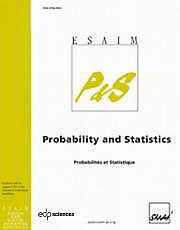Article contents
Coupling a branching process to an infinite dimensional epidemic process***
Published online by Cambridge University Press: 15 December 2008
Abstract
Branching process approximation to the initial stages of an epidemic process has been used since the 1950's as a technique for providing stochastic counterparts to deterministic epidemic threshold theorems. One way of describing the approximation is to construct both branching and epidemic processes on the same probability space, in such a way that their paths coincide for as long as possible. In this paper, it is shown, in the context of a Markovian model of parasitic infection, that coincidence can be achieved with asymptotically high probability until MN infections have occurred, as long as MN = o(N2/3), where N denotes the total number of hosts.
- Type
- Research Article
- Information
- Copyright
- © EDP Sciences, SMAI, 2010
Footnotes
Work supported in part by Schweizerischer Nationalfonds Projekt No. 20–117625/1.
To Cindy Greenwood, for her 70th.
References
- 5
- Cited by




